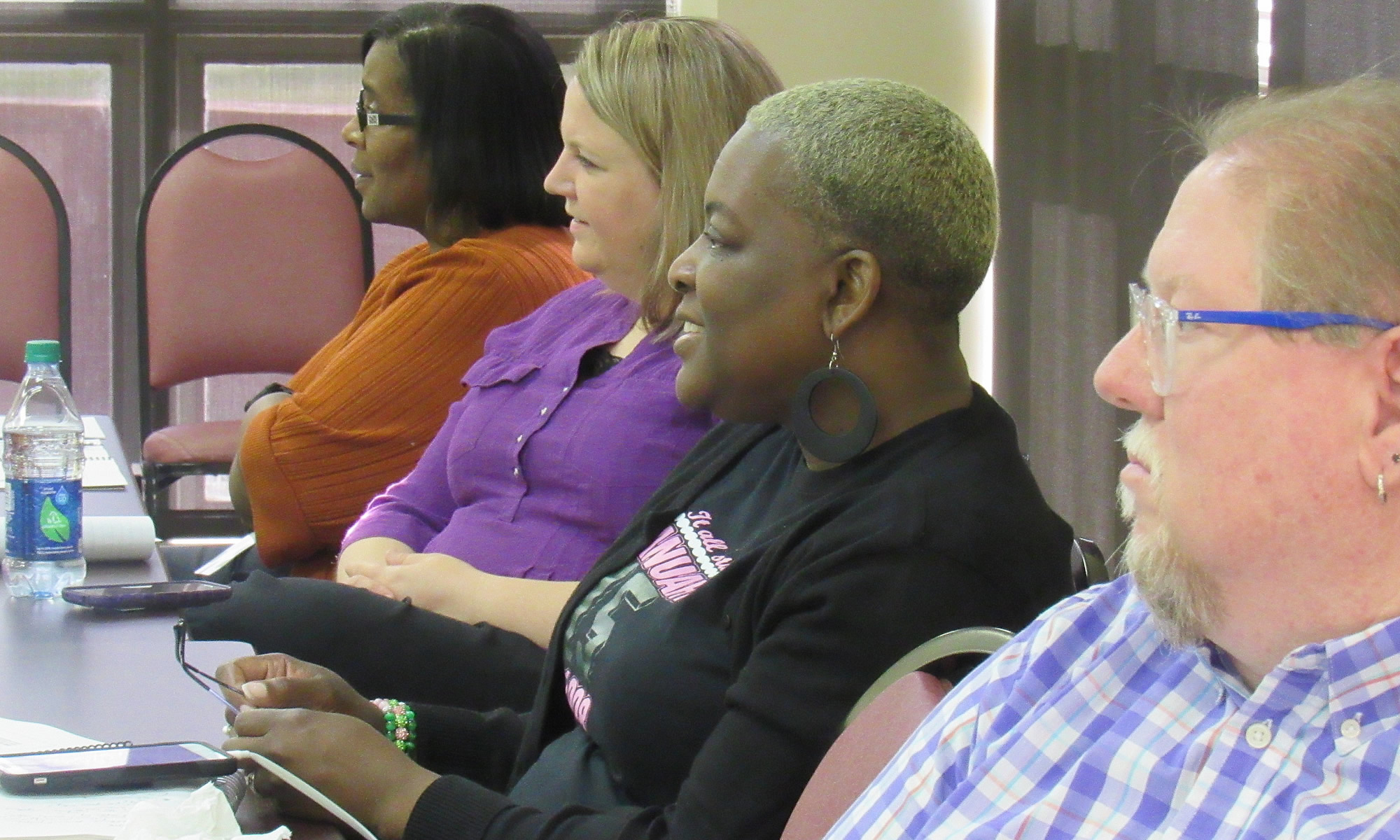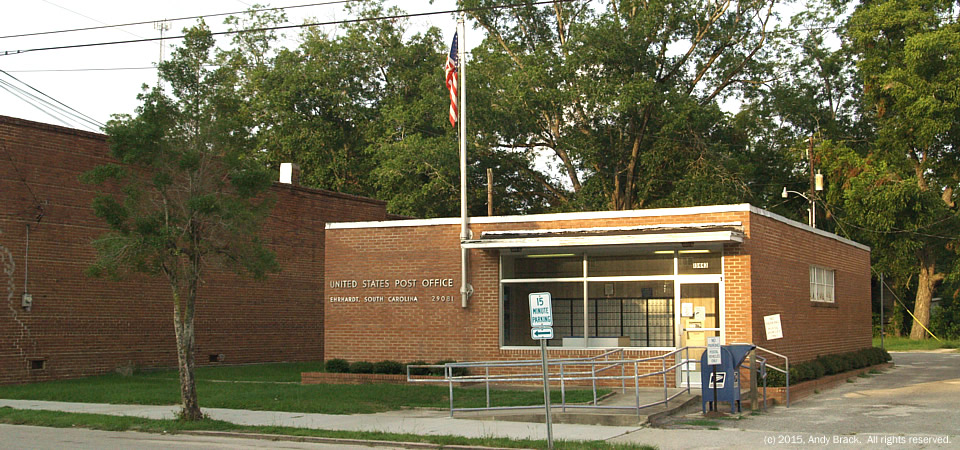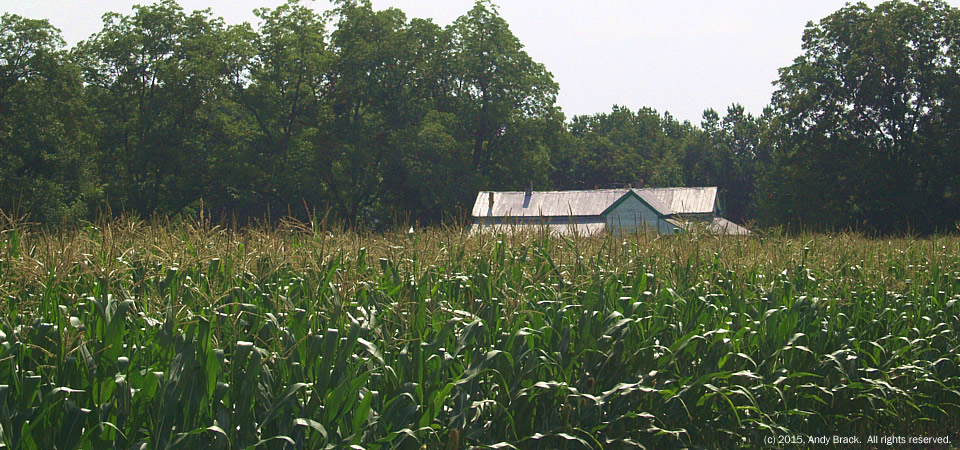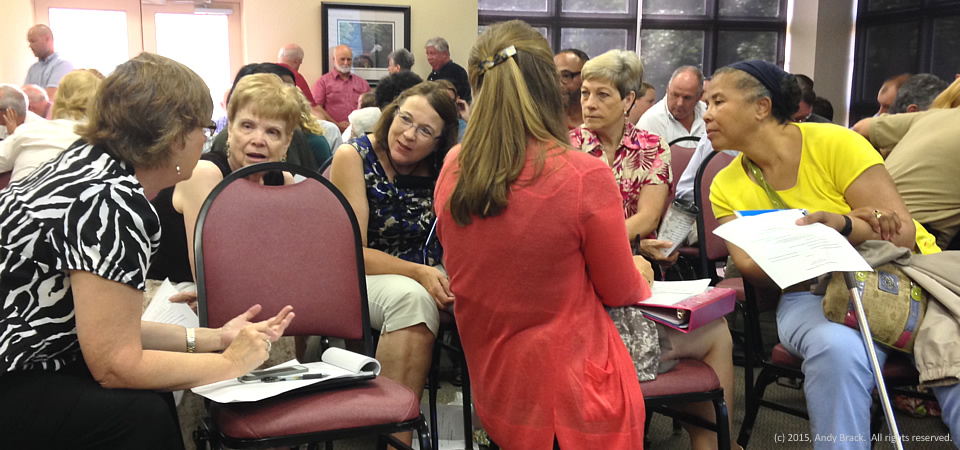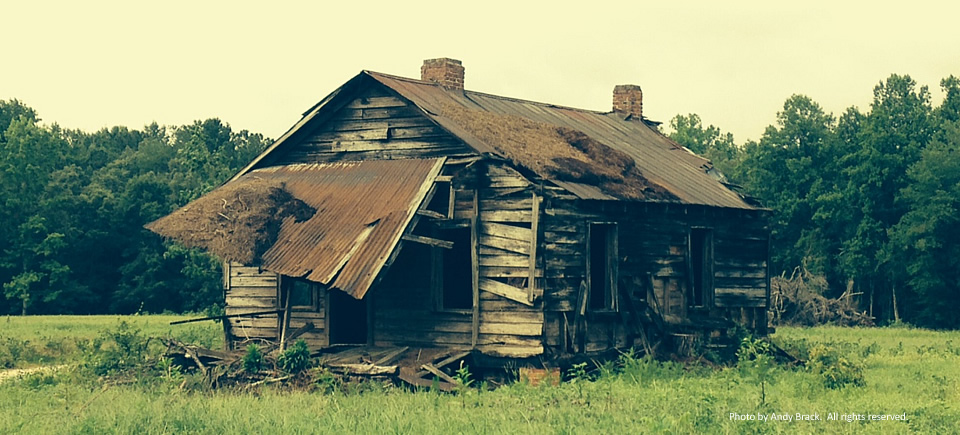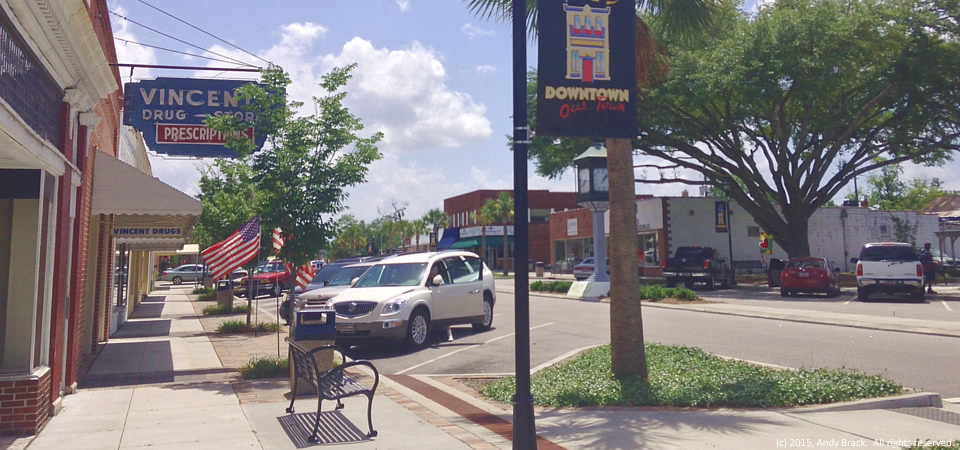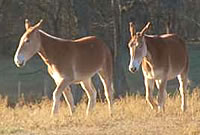A familiar feature in many small towns across the South is the standard 1960s post office, like the one pictured here in Ehrhardt, S.C. With challenges faced by the U.S. Postal Service and reductions in population in rural communities, small post offices face survival challenges. Photo by Andy Brack. All rights reserved.
Corn on a muggy day, Denmark, S.C.
Town hall meeting, Barnwell, S.C.
The SouthernCarolina Alliance, lead organization of the new South Carolina Promise Zone, held three town hall meetings in recent days to listen and learn to what residents dream for to make real and lasting change in the region. The Alliance will hold three more meetings in coming days. The Center for a Better South is a supporting organization of the Promise Zone. Learn more.
- Copyrighted photo by Andy Brack taken July 9, 2015, in Barnwell, S.C. All rights reserved.
Summer job, Bamberg, S.C.
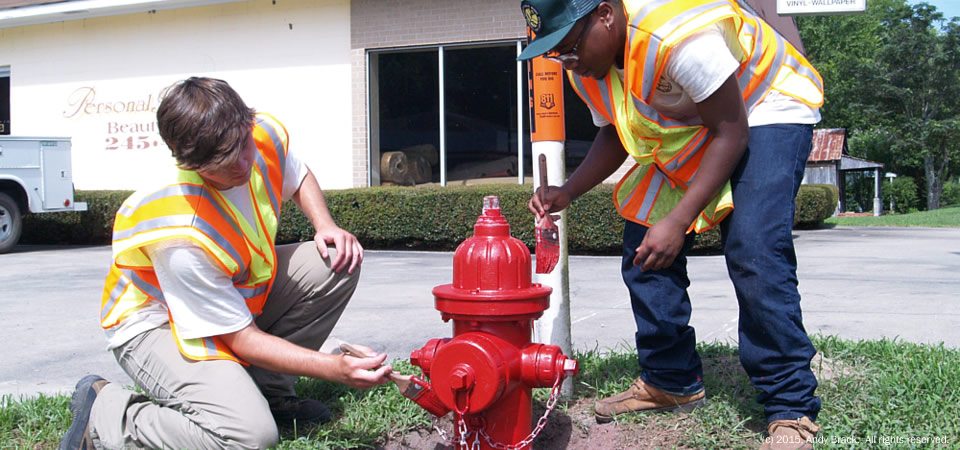
On a sweltering South Carolina summer Thursday, rising college sophomores Ethan Kemp, at left, and Robert Steedley, both of Bamberg, S.C., painted a fire hydrant in their hometown as part of their summer jobs with the public works department. Kemp attends the University of South Carolina, while Steedley attends Claflin University in nearby Orangeburg.
Just over 30 percent of the 15,987 people in Bamberg County in 2010 lived below the poverty level, according to the U.S. Census. The county included 254 people born outside of the United States. The majority of residents are black (61.5 percent) with whites comprising 36.1 percent. Some 1.6 percent of residents are Latino while 0.4 percent are of Asian descent.
- QuickFacts about Bamberg County from the U.S. Census.
Copyrighted photo taken July 9, 2015 by Andy Brack. All rights reserved.
Old house, near Cameron, S.C.
This old, dilapidated farmhouse sits in a fallow field on U.S. Highway 176 near Cameron, S.C. The agricultural community of just over 400 people has a poverty rate of 12 percent, about two-thirds of the state average.
Copyrighted photo by Andy Brack. All rights reserved.
Center to facilitate Promise Zone town hall meetings
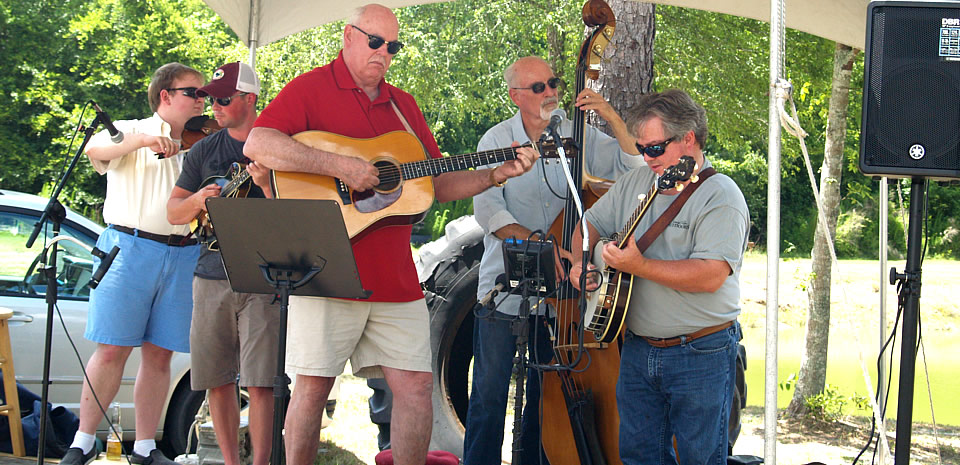
JUNE 24, 2015 — The Center for a Better South will coordinate and conduct a series of six town hall meetings in July in the recently-announced Promise Zone that encompasses six challenged counties at the southern tip of South Carolina.
“This is a phenomenal chance to interact with neighbors and leaders throughout Allendale, Bamberg, Barnwell, Colleton, Hampton and Jasper counties to share with them about the huge opportunities that the Promise Zone designation provides to grow jobs, improve education and reduce crime,” said Andy Brack, president and chairman of the Center. “These town hall sessions throughout July also will give people a chance to have their say about the strengths, weaknesses and opportunities as the region pushes forward to embrace new ways to tap into federal money to vastly improve people’s lives.”
On April 28, the Obama Administration announced the six counties in the Southern Carolina region won the nation’s second rural Promise Zone designation. Only 20 of the special designations are to be awarded across the nation. The innovative program allows Allendale, Bamberg, Barnwell, Colleton, Hampton and Jasper counties to access into federal money and other opportunities in new ways to grow jobs, improve education and reduce crime. The Southern Carolina Regional Development Alliance is coordinating the effort with the six county governments and an array of public, private and nonprofit partners.
The Alliance has contracted with the Center to conduct the town hall meetings, a key step in developing a long-term strategic plan to coordinate the myriad opportunities provided by the designation, Brack said. The Center will work with The Weathers Group, based in Columbia, S.C., to facilitate the town hall meetings.
“We’d like to encourage as many people in the counties to attend these town hall meetings so that we get as diverse and broad of community input as we can,” Brack added. “It’s open to students, neighborhood leaders, elected officials, business executives, nonprofit leaders and more.”
Here is the schedule of meetings in July:
Allendale County Town Hall meeting
- WHEN: 4:30 p.m. to 6 p.m., July 8, 2015 (doors open at 4 p.m.)
- WHERE: Science Administration Building, 465 James Brandt Blvd., USC-Salkehatchie, Allendale
- PARKING: Large parking lot outside of the building
Bamberg County Town Hall meeting
- WHEN: 8 a.m. to 9:30 a.m., July 8, 2015 (doors open at 7:30 a.m.)
- WHERE: Massachusetts Hall, Voorhees College, 213 Wiggins Dr., Denmark, SC
- PARKING: Adjacent to Massachusetts Hall
Barnwell County Town Hall meeting
- WHEN: 8 a.m. to 9:30 a.m., July 9, 2015 (doors open at 7:30 a.m.)
- WHERE: Edisto Room, SouthernCarolina office, 1750 Jackson St., Barnwell, S.C.
- PARKING: Guests are encouraged to park in the lot behind the building at 54 Irving St., Barnwell
Colleton County Town Hall meeting
- WHEN: 8 a.m. to 9:30 a.m., July 15, 2015 (doors open at 7:30 a.m.)
- WHERE: Main Classroom Building, Room 111, USC Salkehatchie, 807 Hampton St., Walterboro
- PARKING: Large parking lot outside of the building
Hampton County Town Hall meeting
- WHEN: 4:30 p.m. to 6 p.m., July 15, 2015 (doors open at 4 p.m.)
- WHERE: Market Square, 45 W. Carolina Avenue, Varnville, SC
- PARKING: Outside of the building
Jasper County Town Hall meeting
- WHEN: 8 a.m. to 9:30 a.m., July 16, 2015 (doors open at 7:30 a.m.)
- WHERE: Jasper County Council chambers, Jasper County Government Building, 358 Third St., Ridgeland, SC
- PARKING: Outside of the building
For more information, contact the Center at: brack@bettersouth.org.
Two years later, Hampton, S.C.
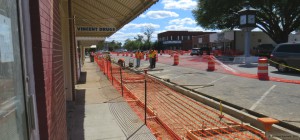
Compare the above photo of downtown Hampton, S.C., with this one taken almost two years earlier when construction was being done to revamp the central business district. Looks a lot better, huh?
The downtown appeared vibrant despite the fact that this Promise Zone county is home to 4,000 fewer people in 2010 than it was a century ago. More. Some 22.6 percent of Hampton County’s 21,900 residents live below the poverty line.
Hampton’s annual Watermelon Festival is the state’s longest, continually-running festival. The town of Hampton includes a brownfield of a former medical waste incinerator. More.
Photo by Andy Brack, copyright 2015. All rights reserved.
Bounty on the way
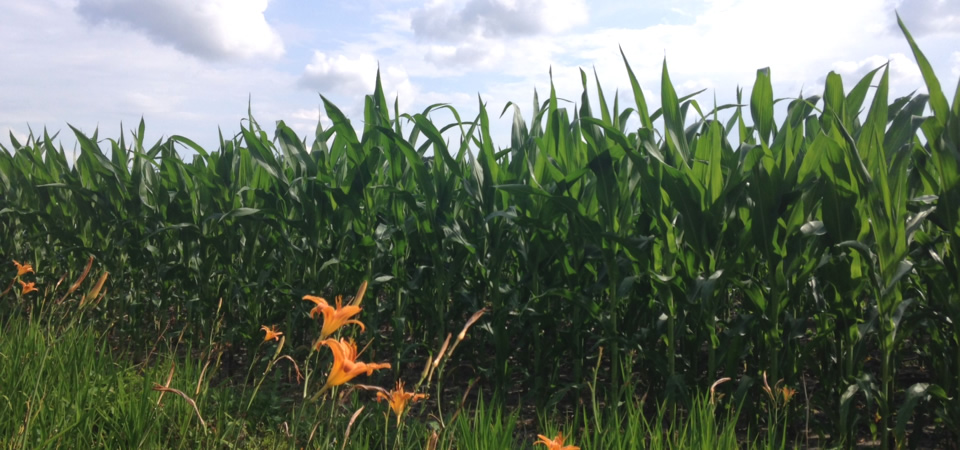
It’s that time of year — the time of year that the land is producing acre upon acre of bountiful food. This corn field, along U.S. Highway 176 at the Calhoun-Orangeburg county line, illustrates the continuing importance of agribusiness to the Palmetto State. Coming soon: Fresh tomatoes, beans, squash and more. (Photo by Andy Brack)
Two mules, Florence County, S.C.
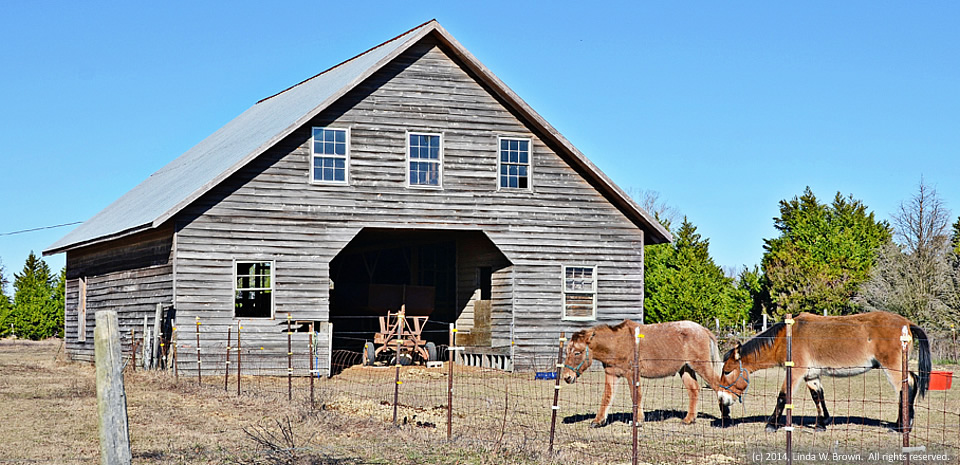
These two mules live in Florence County on S.C. Highway 341 between Lake City and Johnsonville. Photographer Linda W. Brown of Kingstree recalls how mules, once a normal part of the Southern countryside, now are seen only rarely.
In 2010, Better South President Andy Brack wrote a commentary on the disappearance of mules across the region. He wrote in Charleston Currents:
Back in 1930, there were about 5.4 million mules in the United States, according to Census data. Today? 283,806 mules and donkeys, according to 2007 Census numbers, which combined both types of animals into one category. South Carolina had 188,895 mules in 1930, compared to 1,620 mules and donkeys today.
So what happened? Mechanization and World War II.
“When the army started to get tanks, mules pretty much went by the wayside” because they weren’t needed to pull artillery and do other work that could be done by machines, said Leah Patton, registrar of the American Donkey and Mule Society in Lewisville, Texas.
Farmers started plowing with tractors. Farm families started traveling by car or truck. Because mules, a cross between a horse and donkey, are sterile and can’t breed, the species’ numbers dropped dramatically.
Patton’s society has more than 70,000 donkeys and mules registered in an attempt to keep alive the interest in the animals. Most people, she noted, don’t register mules because they are only around for their lifetimes.
But mules are still revered in some corners where people use them for more recreational purposes — showing them and riding them. And you can still find them hard at work in developing countries where people live off the land and don’t have enough money for tractors.
Photo is copyrighted by Linda W. Brown; taken in December 2014. All rights reserved.
Dropping prices, Hardeeville, S.C.
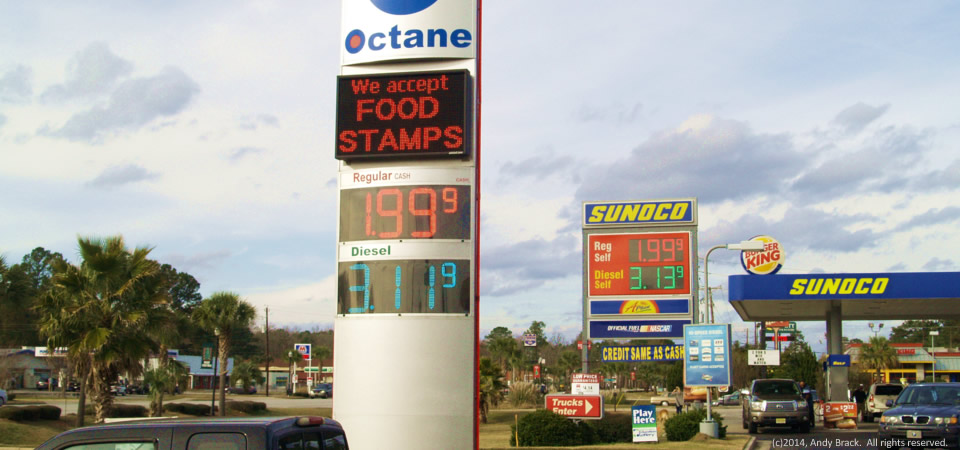
It’s hard to believe that prices for gasoline are below $2.00 in some parts of the Southern Crescent. Several stations at the Hardeeville, S.C., exit of Interstate 95 had low prices on Sunday, although in nearby Ridgeland, gas cost $0.50 more per gallon. Both are in Jasper County.
Jasper County, population 25,833, is just over the river from Savannah, Ga. Its location near the metro area likely is why poverty in Jasper County (21.4 percent) is half that of Allendale County to the north. Ridgeland has a poverty rate of more than 24 percent, while Hardeeville’s rate exceeds 32 percent.
Photo by Andy Brack, taken on Dec. 28, 2014. All rights reserved.
